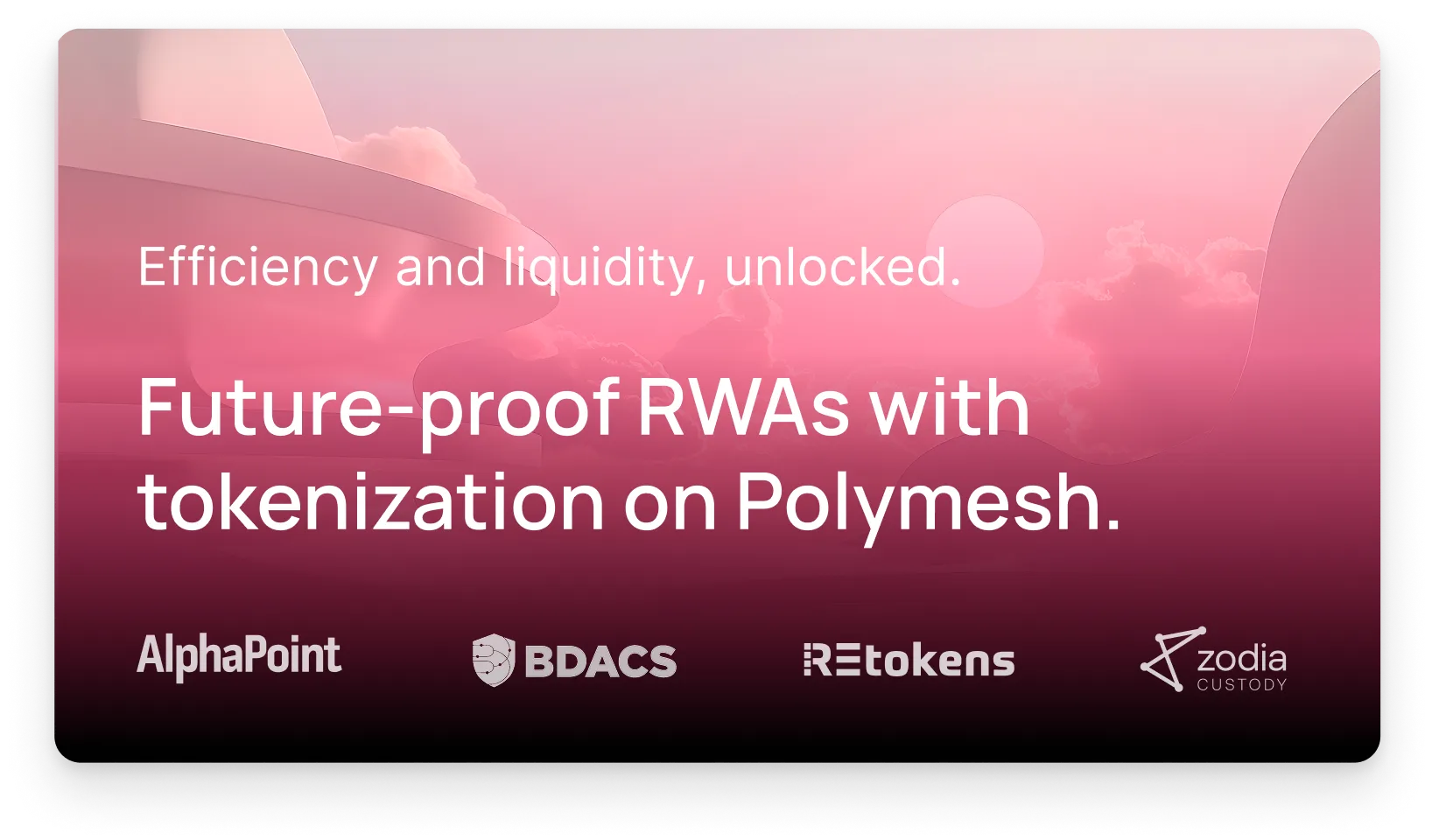A Spotlight on Digital Asset Regulation in Singapore
Understanding digital asset regulation is especially important for Polymesh users–after all, Polymesh is a blockchain specifically built for regulated assets!
To help our users become better acquainted with the global regulatory situation, we’re offering a series of posts spotlighting specific locals.
This post focuses on digital asset regulation in Singapore, which has taken a considerably positive attitude towards cryptocurrencies and blockchain.
In the APAC region, where cryptocurrency receives a heavily mixed reception (as exemplified by China outright banning it), Singapore is emerging as a keen proponent of blockchain technology and helping to cement the region as a crucial hub for cryptocurrency innovation.
The main player: the Monetary Authority of Singapore (MAS)
One key factor in Singapore’s swift passing of digital asset regulation is the city-state’s cohesive government structure. Unlike the US, Singapore’s government system features only one domestic financial regulator with ultimate authority over digital asset regulation: the Monetary Authority of Singapore (MAS). The MAS functions as a hybrid central bank and financial regulator with a dual mandate to encourage the financial sector’s development.
In 2019, the Parliament of Singapore passed the Payment Services (PS) Act, bringing cryptocurrency dealing or exchange services under supervision of the MAS. The PS Act gives a regulatory licensing and operating framework for payment systems and service providers in Singapore, including digital payment token (DPT) services or cryptocurrency. DPT service providers are payment institutions, banks, other financial institutions, and applicants under the PS Act that offer DPT services.
Singapore’s PS Act was designed to provide regulatory certainty and consumer safeguards while encouraging innovation and growth within the financial sector, including decentralized finance. In a rather novel move, Singapore’s PS Act not only explicitly includes digital payment token (DPT) services but also explicitly defines certain regulated non-security digital tokens, such as bitcoin, as well as regulated e-money (or stablecoins) whose issuers require a special license.
The enactment of the PS made the MAS one of the first few financial services regulators in the world to introduce a regulatory framework for crypto. Its focus is primarily on anti-money laundering (AML) and technology risk management, and increasingly, customer protection.
Different token types under MAS jurisdiction
The MAS defines crypto assets or tokens as digital representations of anything we regard as having value.
The general view of the MAS is that digital securities remain securities, so there’s no real change to existing regulation. This leaves two regimes for regulating tokens: the pre-existing Securities and Futures Act and the newer Payment Services Act.
When it comes to tokenized securities, the rule book is relatively clear: they’re regulated by the Securities and Futures Act. The Securities and Futures Act features an exhaustive list of characteristics defining a security that makes it easy for lawyers to determine whether a digital asset is a security or a non-security digital token.
If a crypto token is being offered as a security with an expectation of a return, such as a share or a bond, it belongs to the former category and is regulated under the Securities and Futures Act similar to other capital markets products. If it’s being offered as a payment token, it is regulated under the Payment Services Act.
MAS' regulatory approach: activity-focused
When it comes to tokens, the MAS has stated that it looks at the underlying activity, the nature, and the quality of the crypto asset to determine the specific risk it poses and then right-sizing regulation.
The MAS takes a similar approach to digital assets-related services and service providers, regulating them based on activity rather than entity and shaping regulation to manage those risks while allowing space for innovation.
This approach has so far left digital payment token licensees in a unique position of being held to the same high AML standards as banks but enjoying a lighter regulatory regime overall (because they don’t conduct the same activities banks do).
Still, the MAS is firm on its expectation that crypto service licensees perform their own risk assessment of new products and technologies to address money laundering and terrorist financing risks. Specifically, firms should have a formal assessment on whether a product can promote anonymity, is known to be used by criminals for illicit purposes, and whether volatility and liquidity of the product render it susceptible to market manipulation.
Digital token providers must also be able to comply with value transfer rules and transmit necessary originator and beneficiary information to the beneficiary service provider immediately and securely.
Project Ubin: Using DLT for clearing and settlement of payment and securities
The MAS knew blockchain was misunderstood early on, making a case for its potential benefits to the Singapore financial sector for the clearing and settlement of payments and securities and being among the first countries to embrace practical experimentation of the technology.
In 2016, the MAS asked itself whether it could create a more efficient inter-bank payment and settlement system without the MAS acting as a trusted party. Thus began Project Ubin, a collaborative effort between the MAS, the Singapore Exchange (SGX), ten banks, eight technology companies, and six academic institutions.
Now complete, Project Ubin was a multi-year multi-phase project, with each phase aimed at solving the pressing challenges faced by the financial industry and blockchain ecosystem.
Project Ubin's 5 Phases
- Phase 1 involved the issuance of a digital representation of the Singapore Dollar (a CBDC) on an Ethereum-based prototype and demonstrated domestic inter-bank settlement was possible without intermediation by the MAS
- Phase 2 demonstrated the blockchain was capable of supporting the critical features of a payment system, specifically by achieving decentralized netting of payments in a manner that preserved transactional privacy
- Phase 3 demonstrated that tokenized assets on different blockchain networks could be simultaneously exchanged, reducing risks for transacting parties
- Phase 4 extended the application to cross-border payment and settlement by collaborating with Project Jasper by the Bank of Canada to test possible models of cross-border, cross-currency payments across different blockchain platforms
- Phase 5 validated the use of smart contracts for use cases such as Delivery-versus-Payment (DvP) settlement with assets on private exchanges and highlighted the commercial potential of blockchain-based multi-currency payment networks
Overall, Project Ubin’s findings pave the way towards live adoption of blockchain technology for clearing and settlement in Singapore’s financial sector. But its originators conceive of its applications extending far wider than the settlement of securities and cash.
Then-Assistant Director of the MAS’ Fintech & Innovation Group Wee Kee Toh asks “what if we look beyond and explore, say, physical assets such as property titles. Can they be tokenized? This would allow for cheaper, faster transactions. Additionally, we could reduce the need for manual processes, and have them automated with smart contracts.”
Further exploration of blockchain technology and CBDCs
The success of Project Ubin also inspired the MAS to initiate two other blockchain-based settlement projects:
- Partior, a block-chain based interbank clearing and settlement network for cross-border payments in different currencies in real time, using either commercial bank digital money or wholesale CBDCs; and
- Project Dunbar, a blueprint for a multi-currency settlement platform operating across countries using wholesale CBDCs in partnership with the Bank for International Settlements Innovation Hub, Reserve Bank of Australia, Bank Negara Malaysia, and South Africa Reserve Bank
MAS: The future of finance is with blockchain and Web 3.0
At the Singapore Fintech Festival in November 2021, the MAS’ Managing Director and longtime blockchain-proponent Ravi Menon gave a speech on ‘The Future of Money, Finance, and the Internet’ that clarified the MAS’ view towards cryptocurrency and blockchain.
Menon reiterated that entities which provide services related to digital payment tokens in Singapore are subject to licensing and supervision by the MAS primarily for money laundering and terrorist financing risks.
While Menon warned that cryptocurrencies or tokens are risky investment assets for retail investors due to their sharp speculative swings, he was quick to follow this with a statement on the MAS’ belief that blockchain has many potential benefits, particularly “applications where it is important to know the history of ownership and transfer of value but there is no trusted central party, or reliance on a central party is too costly”. Common examples include cross-border payments and trade finance.
Menon then went on to highlight three factors the MAS predicts will drive innovation in the future of finance:
- Industry collaboration through technology and data sharing platforms, such as decentralized credentials platforms that can help financial institutions ascertain the reliability and capacity of fintech firms they wish to collaborate with
- Smart contracts and tokenization, which is already being used to enhance market infrastructure for financial assets in Singapore (e.g. Menon cites Olam International’s digital bond on SGX’s digital issuance, depository, and servicing platform)
- Web 3.0, or the phenomenon of decentralized finance (DeFi), where end-users perform financial transactions directly with one another using smart contracts without the need for financial intermediaries–what Menon calls a “fundamentally different approach to financial infrastructure compared to the centralized systems of today” and “already a growing reality, albeit nascent”.
The future of Web 3.0
When it comes to Web 3.0 or DeFi, Menon’s speech shows the MAS did not view crypto networks as currently capable of meeting the high standards of governance, security, and resilience banks and regulators require of critical infrastructure. Key issues were “flash loans” that manipulate prices in the market, bots used to front-run retail trades, and the looming question of account or fund recovery in the event of loss or a mistaken transfer.
Nevertheless, the MAS clearly had its eyes on DeFi. Menon himself mentioned that existing regulatory frameworks need to be adapted for DeFi to become a reality as regulations created for risk management in a world of intermediaries are incompatible when intermediaries are replaced by smart contracts. He also stated it’s the MAS’ intention to follow developments within DeFi closely to deepen its understanding and work with the financial industry and broader ecosystem to find a balance between harnessing the benefits while managing the risks.
Its first move on the matter came only two months later when the MAS began cracking down on cryptocurrency promotions.
MAS cracks down on cryptocurrency promotions
True to its mandate of encouraging the financial sector’s development while protecting consumers, in January 2022 the MAS issued the ‘Guidelines on Provision of Digital Payment Token Services to the Public’, which stresses that DPT or cryptocurrency service providers should conduct themselves with the understanding that trading of DPTs or cryptocurrency is not suitable for the general public.
Similar to the FCA’s opinion in the UK (and suggesting this may be a trend we’ll see in more countries), the Guidelines seek to restrict marketing of digital assets/digital payment token services to the general public in Singapore. Specifically, the Guidelines stipulate that DPT service providers may promote their services on their own platforms or channels (e.g. their own corporate website, mobile applications, or official social media accounts) but must not trivialize the risks of trading in a way that is inconsistent with or contradicts the risk disclosures of the PS Act.
The new guidelines clarify that DPT service providers are prohibited from engaging in marketing or advertising of DPT services in public areas (e.g. public transport, public transport venues, public websites, social media platforms, broadcast and print media, or provision of physical ATMs) or through the engagement of third parties (e.g. social media influencers).
Notably, the Guidelines also expand the definition of DPT services to include the transfer of DPTs and provision or custodian wallet services for DPTs in addition to the buying or selling of DPTs or facilitating the exchange of DPTs.
As with the UK, Singapore’s stance that retail investors should avoid trading cryptocurrency has pushed some crypto-giants away. The regional arm of Binance, for example, shut down last December.
But cryptocurrency seems widely accepted among Singapore’s citizens already: a survey from 2021 found that 93% of Singaporeans had heard of cryptocurrency with nearly 50% already owning it, while 76% of Singaporeans between the ages of 26-35 believed cryptocurrencies would eventually become widely available to businesses and people.
Project Guardian: Singapore's sandbox for tokenized assets
While the global crypto market faced high levels of uncertainty amid government crackdowns this past May, Singapore launched a new project to test the tokenization of financial assets and explore the potential of decentralized finance applications in wholesale funding markets.
Called “Project Guardian”, the pilot program will see the MAS collaborate with industry players to explore the feasibility and economic potential of autonomous trading powered by blockchain technology while evaluating the necessary regulations to safeguard against potential risks to financial stability and integrity.
As part of the initiative, the MAS selected JPMorgan Chase to conduct a new blockchain trial examining the possibilities of decentralized finance (DeFi). The investment bank was chosen because of its experience integrating digital assets and blockchain technology– JPMorgan’s Onyx Digital Assets Network has executed over $300 billion in transactions trading tokens in fixed income markets.
While the MAS is receptive to using a public blockchain for Project Guardian, tokenized bonds and deposits will be deployed to a private permissioned liquidity pool for the pilot. It’s not clear just yet how the findings of Project Guardian will be utilized by the MAS to shape the country’s crypto-policymaking, but one thing is certain: Singapore is trailblazing in its enthusiastic embrace of blockchain technology and encouragement of industry innovation.
How Polymesh lines up with Project Guardian's four tenets
Project Guardian will test the feasibility of asset tokenization and DeFi by developing and piloting use cases in four main areas, each of which is aligned with Polymesh:
- Open, interoperable networks – Exploring the use of public blockchains to build open, interoperable networks that enable digital assets to be traded across platforms and liquidity pools, including with existing financial infrastructure.
Right away the alignment should be obvious; Polymesh was designed for exactly this purpose! A public layer-1 blockchain with financial primitives, Polymesh provides the perfect base-layer infrastructure for financial institutions to issue and trade digital assets, whether on their own platform or across platforms on different networks. Chain interoperability is enhanced through smart contracts, which are currently available on testnet.
- Trust anchors – Establishing a trusted environment for the execution of DeFi protocols through a common trust layer of independent trust anchors (regulated financial institutions that screen, verify, and issue verifiable credentials to entities that wish to participate in DeFi protocols).
Trust anchors ensure that participants trade only with verified counterparties, issuers, and protocol developers. On Polymesh, trust anchors are embedded in the permissioning layer and are a key component of identity on the blockchain. Users must have a verified identity through a third-party customer due diligence provider in order to use the chain, while node operators must only be licensed financial entities who have undergone a know-your-business process.
- Asset tokenization – Examining the representation of securities in the form of digital bearer assets and the use of tokenized deposits issued by deposit-taking institutions on public blockchains. Project Guardian also aims to build upon existing token standards and incorporate trust anchor credentials.
Again, another clear alignment. As a blockchain for security tokens, asset tokenization is something Polymesh has thought a lot about. Security tokens on Polymesh are inspired by the ERC-1400 security token standard (the first unified standard for security tokens) but build in additional capabilities around governance, identity (or ‘trust anchor credentials’), compliance, confidentiality, and settlement. As a result, many more functions are possible for digital assets on the blockchain (e.g. identity-driven permissions access; security identifiers; portfolio-based custody).
- Institutional grade DeFi protocols – Studying the introduction of regulatory safeguards and controls into DeFi protocols to mitigate against market manipulation and operational risk. The project will also examine the use of smart contract auditing capabilities to detect code vulnerabilities.
For this last area too, it’s easy to see how Polymesh– an institutional-grade blockchain built to meet regulatory needs when it comes to tokenized assets–and Project Guardian’s goals and ideals are aligned. For example, Polymesh combines fork-resistant technology with an industry-leading governance model to prevent hard forks and steer past potential disagreements. As a result, there’s always one canonical version of the chain.
Ultimately, it’s clear that Polymesh is an initiative which addresses Project Guardian’s four areas of interest and would be welcomed by the MAS as a responsible digital asset innovation.
The 'double-helixes' of emerging blockchain technology
As Web 3.0 and blockchain make waves in the world of technology and finance, the Singaporean government has proven that it’s looking to surf with these trends as opposed to against them.
This was exemplified at the fintech community’s Point Zero Forum in June 2022, when Deputy Prime Minister and Coordinating Minister for Economic Policies Heng Swee Keat identified three ‘double-helixes’ around which the winds of change are propelled: Swiss-Singapore relations, Digital-Sustainability, and Industry-Regulator.
Below we’ll discuss the two that have direct bearing on Polymesh.
How Polymesh can play a role in Swiss-Singapore collaboration
At the Point Zero Forum, Heng drew attention to the common interests and perspectives shared by Switzerland and Singapore as two small countries and global financial centers with a decisively international outlook.
Global financial centers often view each other competitively, especially when it comes to their ability to attract assets under management and talent. But new frontiers thrive better when there’s also a circulation of innovation and ideas. This is particularly the case for blockchain; reducing barriers to cross-border transactions and creating common frameworks for the responsible use of the technology will require regulatory and industry cooperation not only within nations but between them.
In Heng’s eyes, finding this balance between competition and cooperation is especially important for Singapore and Switzerland. Both countries have maintained close and complimentary financial relations, and have held financial dialogues and regulatory exchanges for years, including for the field of fintech–the point Zero Forum was one such joint creation.
As a not-for-profit entity based in Switzerland, this desire to strengthen Swiss-Singapore collaboration in the field of blockchain is exciting news for the Polymesh Association.
First, it signals an openness of Singaporean regulators to embrace the innovation connected to the region to which Polymesh is directly tied.
Second, it shows how Polymesh–a blockchain built specifically for regulated assets–is well-positioned to attract institutional attention as international regulatory and industry collaboration increases.
Finally, it shows that Singaporean regulators and Polymesh are of one mind when it comes to the importance of crafting technology to meet regulatory needs (more on this below).
A perfect fit within the Industry-Regulator double-helix
At the national level, Heng drew attention to the common goal of regulators and the fintech community to use finance and technology to create value and improve human lives.
As with global financial centers, Heng claims there’s no benefit to the fintech industry and regulators working at cross purposes to each other and that they should instead partner in the exploration and promotion of innovation while managing adverse risks–particularly when it comes to Web 3.0, which Heng views as creating many possibilities.
The possibilities he mentions are all ones which Polymesh enables:
- Tokenization + the fractionalization of assets, which allows for greater liquidity and better price discovery
- Distributed ledgers which can operate without intermediaries, reduce costs, and discourage rent-seeking behavior
- Allowing for instant settlement to significantly reduce settlement risks
Significant? We think so! After all, it’s a recognition that regulators are keen to harness the benefits of blockchain for regulated assets… and what better place to start than with a blockchain built specifically for that purpose and for which asset tokenization, decentralized governance, and instant settlement are top of mind?
Moreover, it’s clear that Singaporean regulators see the value of industry-regulatory collaboration, as did the Polymesh team when they conceived that the only way for the market to fully embrace security tokens was through the creation of a blockchain purpose-built for institutional and regulatory needs.
While Heng recognizes the value of digital assets for a variety of use cases, he and Singapore’s regulators view the greatest value of blockchain in its ability to improve efficiency in wholesale market activities such as cross-border transactions, trade finance, and capital markets. Hence Singapore’s early experimentation with regulatory sandboxes in these fields, including the feasibility of DeFi and asset tokenization–also the primary purpose for which Polymesh was designed.
In regards to the future, Heng stated that Singapore will continue to do pioneering work in decentralized finance, and that the city-state is committed to partnering with innovative and responsible blockchain and digital asset players to grow the Web 3.0 ecosystem and community. Hopefully they include members of the Polymesh ecosystem, because there’s definitely an overlap in interest.
Overall, Heng’s speech makes it explicit that Singapore is keen to continue building trust in the Web 3.0 tech wave through regulatory guardrails that can manage risks while encouraging innovation and reaping blockchain’s benefits–an approach which meshes well with Polymesh, which was built to solve the risks of public blockchain infrastructure for regulated assets.
Continued plans to become a cryptocurrency hub
Given Singapore’s clear licensing and regulatory framework for digital assets, it’s no surprise the city-state is seen as at the forefront of crypto legislation. And with the Singapore government keen to work with the fintech industry when setting this framework, it’s no surprise either that it has a crypto-friendly reputation.
But let’s look at the matter more finely.
As of July 2022, the MAS has granted licenses and in-principle approvals to 14 digital payment token service providers, a group which includes stablecoin issuers, crypto exchanges, and traditional finance institutions. The vetting process for applications for such licenses is reported to be strict, with less than 10% of the companies seeking permits having been approved so far.
Regulations are allegedly becoming stricter as well, with the city-state continuing to tighten rules around crypto investments. This includes the clamp down on crypto marketing as well as the requirement that digital asset providers be licensed locally even if they only do business overseas. The MAS has also announced plans to consult on further revisions to the retail-investor access to crypto this autumn, as well as its intention to follow international regulators in broadening the scope of regulations to cover more activities.
When it comes to existing regulations, the focus seems to be on containing money laundering and terrorist financing risks. But it seems this is changing towards including more consumer protection, market conduct, and reserve backing for stablecoins. MAS Managing Director Ravi Menon has said that reviews and public consultations are already underway to strengthen regulation in these areas; proposed measures will be consulted on in the next few months.
The MAS is set to share its strategies on developing Singapore as a digital assets hub this August 2022, including what it perceives as the risks and opportunities as well as shortcomings and potential of emerging blockchain technology, tokenization, and smart contracts.
The most recent update on Singapore’s digital assets strategy comes from a reply to a parliamentary question on the matter on August 1, 2022, where the MAS says its focus is on the broader blockchain ecosystem and its real use cases for wholesale market activities rather than cryptocurrency, for which it remains discouraging retail participation.
The tokenization of RWAs is galvanizing new opportunities for investment yield in DeFi while unlocking liquidity in traditionally illiquid asset classes.


.svg)











































